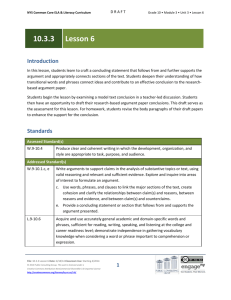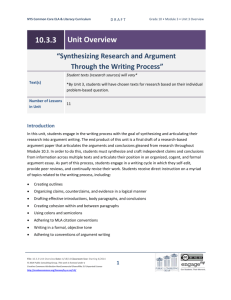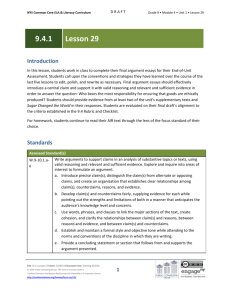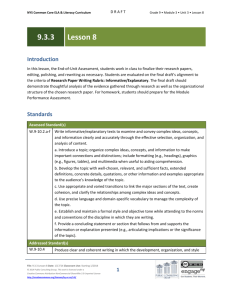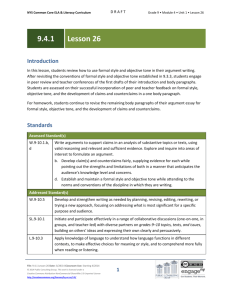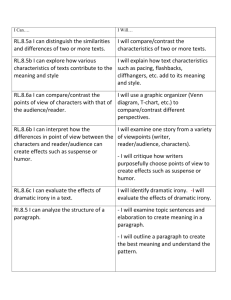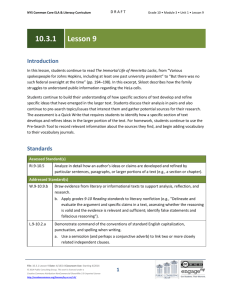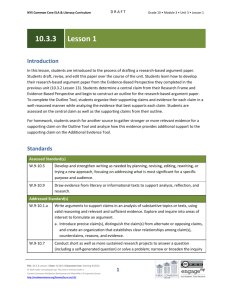139.99 KB - EngageNY
advertisement
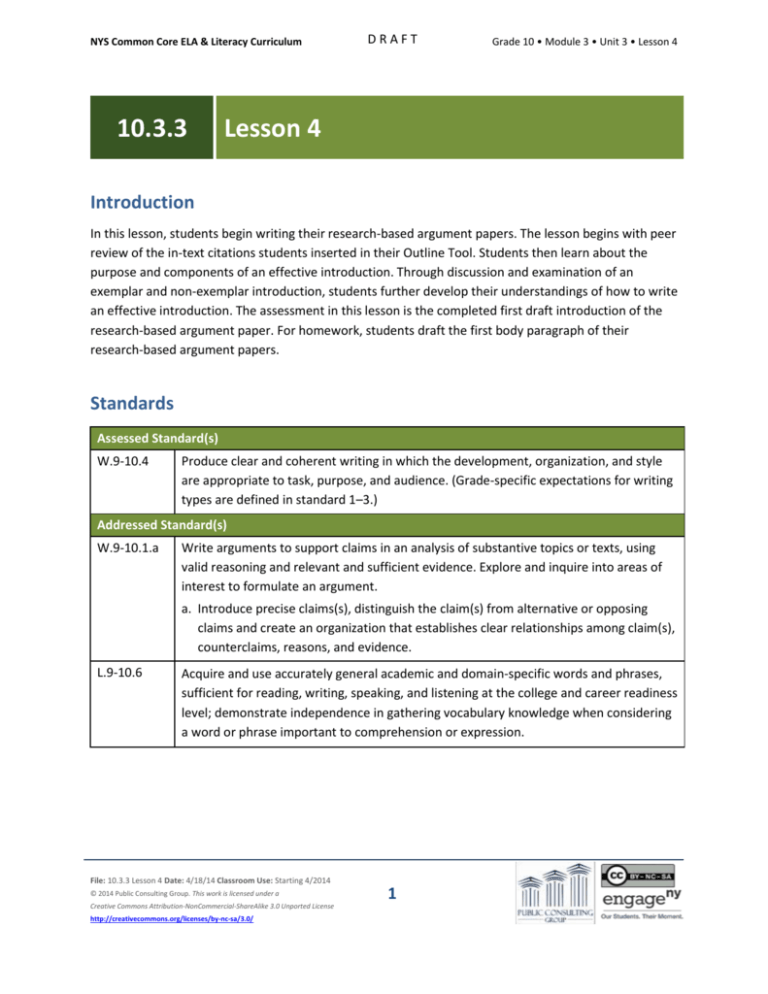
NYS Common Core ELA & Literacy Curriculum 10.3.3 DRAFT Grade 10 • Module 3 • Unit 3 • Lesson 4 Lesson 4 Introduction In this lesson, students begin writing their research-based argument papers. The lesson begins with peer review of the in-text citations students inserted in their Outline Tool. Students then learn about the purpose and components of an effective introduction. Through discussion and examination of an exemplar and non-exemplar introduction, students further develop their understandings of how to write an effective introduction. The assessment in this lesson is the completed first draft introduction of the research-based argument paper. For homework, students draft the first body paragraph of their research-based argument papers. Standards Assessed Standard(s) W.9-10.4 Produce clear and coherent writing in which the development, organization, and style are appropriate to task, purpose, and audience. (Grade-specific expectations for writing types are defined in standard 1–3.) Addressed Standard(s) W.9-10.1.a Write arguments to support claims in an analysis of substantive topics or texts, using valid reasoning and relevant and sufficient evidence. Explore and inquire into areas of interest to formulate an argument. a. Introduce precise claims(s), distinguish the claim(s) from alternative or opposing claims and create an organization that establishes clear relationships among claim(s), counterclaims, reasons, and evidence. L.9-10.6 Acquire and use accurately general academic and domain-specific words and phrases, sufficient for reading, writing, speaking, and listening at the college and career readiness level; demonstrate independence in gathering vocabulary knowledge when considering a word or phrase important to comprehension or expression. File: 10.3.3 Lesson 4 Date: 4/18/14 Classroom Use: Starting 4/2014 © 2014 Public Consulting Group. This work is licensed under a Creative Commons Attribution-NonCommercial-ShareAlike 3.0 Unported License http://creativecommons.org/licenses/by-nc-sa/3.0/ 1 NYS Common Core ELA & Literacy Curriculum DRAFT Grade 10 • Module 3 • Unit 3 • Lesson 4 Assessment Assessment(s) Student learning in this lesson is assessed via the first draft of the introduction for the research-based argument paper. High Performance Response(s) A High Performance Response should: Introduce readers to the topic in an engaging manner (e.g., Grave-robbers, body snatchers, reanimated monsters: this is the stuff of horror films and nightmares. In the real world, human tissue can be removed from a body without consent and used to develop a cell line or genetic map). Effectively communicate the writer’s precise central claim (e.g., Based on the complications inherent in profiting from tissues, granting anyone the rights to sell human tissue is morally and ethically questionable; neither researchers nor patients should have rights to sell any human tissue). Distinguish the central claim from alternative or opposing claims (e.g., Who should own tissue, or profit from tissue after it has been surgically removed from a patient's body?) Establish a path for the paper’s organization of supporting claims, evidence, counterclaims, and reasoning. (e.g., Care must be taken to protect patients and their families from psychological trauma when tissues are removed from the body and used without consent for research or profit. But how much protection is enough?) For more examples, view a model introduction from the sample student research paper on page 7 of this lesson, or the Sample Student Research-Based Argument Paper in 10.3.3 Lesson 11. Vocabulary Vocabulary to provide directly (will not include extended instruction) None.* Vocabulary to teach (may include direct word work and/or questions) None.* *Students should use their vocabulary journals to incorporate domain-specific vocabulary from Unit 10.3.2 into their research paper, as well as to record process-oriented vocabulary defined in the lesson. File: 10.3.3 Lesson 4 Date: 4/18/14 Classroom Use: Starting 4/2014 © 2014 Public Consulting Group. This work is licensed under a Creative Commons Attribution-NonCommercial-ShareAlike 3.0 Unported License http://creativecommons.org/licenses/by-nc-sa/3.0/ 2 NYS Common Core ELA & Literacy Curriculum DRAFT Grade 10 • Module 3 • Unit 3 • Lesson 4 Lesson Agenda/Overview Student-Facing Agenda % of Lesson Standards: Standards: W.9-10.4, W.9-10.1.a, L.9-10.6 Text: “My Body, My Property” by Lori B. Andrews Learning Sequence: 1. 2. 3. 4. 5. 6. Introduction of Lesson Agenda Homework Accountability Drafting an Introduction Analyzing Effective Introductions Assessment Closing 1. 2. 3. 4. 5. 6. 10% 10% 30% 20% 25% 5% Materials Student copies of the 10.3 Common Core Learning Standards Tool (refer to 10.3.1 Lesson 1) Student copies of the 10.3.3 Rubric and Checklist (refer to 10.3.3 Lesson 3) Student copies of the Outline Tool (refer to 10.3.3 Lesson 1) Learning Sequence How to Use the Learning Sequence Symbol Type of Text & Interpretation of the Symbol 10% no symbol Percentage indicates the percentage of lesson time each activity should take. Plain text indicates teacher action. Bold text indicates questions for the teacher to ask students. Italicized text indicates a vocabulary word. Indicates student action(s). Indicates possible student response(s) to teacher questions. Indicates instructional notes for the teacher. File: 10.3.3 Lesson 4 Date: 4/18/14 Classroom Use: Starting 4/2014 © 2014 Public Consulting Group. This work is licensed under a Creative Commons Attribution-NonCommercial-ShareAlike 3.0 Unported License http://creativecommons.org/licenses/by-nc-sa/3.0/ 3 NYS Common Core ELA & Literacy Curriculum DRAFT Grade 10 • Module 3 • Unit 3 • Lesson 4 Activity 1: Introduction of Lesson Agenda 10% Begin by reviewing the lesson agenda and assessed standard for this lesson: W.9-10.4. Inform students that in this lesson, they learn how to draft an effective introduction for the research-based argument paper. Students look at the agenda. Distribute or ask students to take out their copies of the 10.3 Common Core Learning Standards Tool. Inform students that in this lesson they begin to work with a new standard: L.9-10.6. Ask students to individually read L.9-10.6 on their tools and assess their familiarity with and mastery of the standard. Students read and assess their understanding of standard L.9-10.6. Instruct students to talk in pairs about what they think the standards means. Lead a brief discussion about the standard. Student responses should include: o o Use domain-specific words and phrases. Demonstrate vocabulary knowledge by using academic words to aid comprehension. Explain to students that they will work with domain-specific language as they craft their research-based argument papers. Students have done significant work to gather domain-specific language in their vocabulary journals throughout this module. The introduction of this standard is designed to synthesize this work and prepare students to demonstrate mastery by using domain-specific language in the drafting of their research-based argument paper. Activity 2: Homework Accountability 10% Instruct students to take out their Outline Tools (used in Lessons 1 and 2), form pairs, and discuss their use of in-text citations. (The homework prompt from the previous lesson was: Using your Outline Tool from 10.3.3 Lessons 1 and 2, insert in-text citation information for each piece of evidence you have listed.) Specifically, ask students to exchange Outline Tools with their classmate and examine one another’s use of in-text citations, identifying any formatting problems and inconsistencies. Students form pairs and review in-text citations for formatting problems and inconsistencies. Student responses will vary by individual sources. It may be necessary for students to refer to the MLA Citation Handout from 10.3.3 Lesson 3 for correct citation format. File: 10.3.3 Lesson 4 Date: 4/18/14 Classroom Use: Starting 4/2014 © 2014 Public Consulting Group. This work is licensed under a Creative Commons Attribution-NonCommercial-ShareAlike 3.0 Unported License http://creativecommons.org/licenses/by-nc-sa/3.0/ 4 NYS Common Core ELA & Literacy Curriculum DRAFT Grade 10 • Module 3 • Unit 3 • Lesson 4 Differentiation Consideration: As students begin drafting their research papers in this lesson, it may be necessary to review some of the building blocks for effective writing, including parts of speech complete sentences, and sentence complexity. Activity 3: Drafting an Introduction 30% Explain that with the completion of the outline, students can now begin drafting the research-based argument paper, starting with the introduction. Explain that an introduction begins the research-based argument paper. The introduction should be interesting, to catch the reader’s attention, provide context for what will be covered in the researchbased argument paper, and include the central claim and how it is distinguished from opposing claims. An effective introduction should be one to two paragraphs long, and written in a clear, organized fashion that establishes clear relationships among claims, counterclaims, reasons, and evidence. The introduction should state the central claim, which may be the last sentence of the introduction. Finally, explain to students that although they should mention their strongest supporting claims in the introduction, all of the evidence and reasoning that supports the claims will come as the body of the research paper unfolds. Students listen. Display W.9-10.1.a and the exemplar introduction from the article “My Body, My Property” by Lori B. Andrews, located at: http://chicagotribune.com/. Instruct students to read the substandard and consider its components (introduce a precise claim, distinguish it from opposing claims, and create an organization that establishes clear relationships among claims, counterclaims, reasons, and evidence) as they review the exemplar introduction. W.9-10.1.a was introduced in 10.3.3 Lesson 1. Students read W.9-10.1.a and the exemplar introduction. Ask students to Turn-and-Talk in pairs about how this introduction effectively exemplifies the components of W.9-10.1.a. Student responses may include: o o o The author introduces her precise claim in these sentences: “Commercialization of human material can get in the way of life-saving diagnosis and research. And it affects everyone.” (par. 3) She distinguishes it from opposing claims when she says, “the U.S. Supreme Court has made it clear that companies cannot own parts of people” (par. 2) and “human gene patents interfere with research and patient care” (par. 3). She establishes clear relationships among claims, counterclaims, reasons, and evidence throughout the introduction, and then she references those connections in the statement, File: 10.3.3 Lesson 4 Date: 4/18/14 Classroom Use: Starting 4/2014 © 2014 Public Consulting Group. This work is licensed under a Creative Commons Attribution-NonCommercial-ShareAlike 3.0 Unported License http://creativecommons.org/licenses/by-nc-sa/3.0/ 5 NYS Common Core ELA & Literacy Curriculum DRAFT Grade 10 • Module 3 • Unit 3 • Lesson 4 “There’s more at stake in these cases than just an esoteric slice of intellectual property law” (par. 3). Now that students have an understanding of what comprises an effective introduction, ask them to discuss the following question in pairs. How is an introduction different than the body of an essay or paper? An introduction is the first part of an essay or paper. The introduction should clearly communicate the central claim of the paper. It can also be the “hook” that grabs readers’ attention. The introduction should provide a high-level overview of the research-based argument paper without including all of the supporting and counterclaims to be detailed later in the body of the paper. Explain that there are different methods for creating an interesting introduction, but regardless of approach, an effective introduction not only grabs a reader’s attention, but also makes clear the writer’s purpose. Writers can frame an introduction by describing a problem, posing a question, or piquing readers’ curiosity with interesting facts associated with the research. Introductions can also be crafted using an interesting story found during the course of the writer’s research. Instruct students to discuss the following question about the exemplar introduction in pairs before discussing with the entire class. What method did the writer use to get the attention of the reader? Is this an effective method? The writer mentioned the name of a famous movie star first (Angelina Jolie), and followed it with another [unknown] name (John Moore), and then she mentioned “the brain tissue of deceased children” (par. 1). Using the movie star’s name in relation with the other information anchors the reader’s interest, and creates the desire to read more to see how the three are connected. Differentiation Consideration: Consider transitioning students into the pre-established research teams and have them brainstorm interesting ways to introduce their research paper. Allow each student to write a sample, and then instruct students to engage in a round-robin style discussion wherein each student passes his or her sample to a member of the group and the group discusses each sample and how interesting or engaging it is and why. Activity 4: Analyzing Effective Introductions 20% Explain to students that in this activity they review two additional introductions with similar content: one exemplar and one ineffective introduction. Instruct students to look for ways the ineffective File: 10.3.3 Lesson 4 Date: 4/18/14 Classroom Use: Starting 4/2014 © 2014 Public Consulting Group. This work is licensed under a Creative Commons Attribution-NonCommercial-ShareAlike 3.0 Unported License http://creativecommons.org/licenses/by-nc-sa/3.0/ 6 NYS Common Core ELA & Literacy Curriculum DRAFT Grade 10 • Module 3 • Unit 3 • Lesson 4 introduction can be contrasted with the exemplar introduction. Remind students to keep the components of W.9-10.1.a in mind as they contrast the introductions. Students read and contrast both introductions. Differentiation Consideration: If more structure is necessary to support analysis, consider instructing students to annotate each introduction (boxing/circling unfamiliar words or ideas, starring important or repeating ideas, writing a question mark by sections that they are questioning or confused by, writing an exclamation point by sections that strike or surprise them, underlining areas that represent major points, and numbering idea sequences that trace the development of an argument). Exemplar Introduction: Grave-robbers, body snatchers, reanimated monsters: this is the stuff of horror films and nightmares. In the real world, human tissue can be removed from a body without consent and used to develop a cell line or genetic map. Not quite a horror movie, but a nightmare when it happened to Henrietta Lacks and her family: in 1951, doctors removed some of Henrietta’s cells without asking and grew the first line of immortal cells. The Lacks family was in the dark for decades about Henrietta's cells, and what they learned over time was incomplete and misleading information that did nothing to help them understand what had been done to Henrietta and why. It is this fear of the unknown and a lack of understanding concerning medicine and science—that is, how human tissues are used or what can be created from them—that fuels a fear of mad scientists like those in horror films. Care must be taken to protect patients and their families from psychological trauma when tissues are removed from the body and used without consent for research or profit. But how much protection is enough? Who should own tissue, or profit from tissue after it has been surgically removed from a patient's body? Based on the complications inherent in profiting from tissues, granting anyone the rights to sell human tissue is morally and ethically questionable; neither researchers nor patients should have rights to sell any human tissue. Ineffective Introduction: The Lacks family didn’t know for decades about Henrietta’s cells because doctors removed some of the cells without asking first and made them the first line of immortal cells. It was 1951. It makes people afraid of doctors when they don’t understand what is happening, and that is just like what happened with Henrietta’s family. No one told them about Henrietta’s cells for a long time and they should have so the Lacks family could have been protected from all the stress. They weren’t treated fairly. Henrietta’s cells were very important to science, but her family wasn’t, even though no one should actually be able to sell human tissue because it’s not clear who’s right and who’s wrong about it. Instruct students to briefly discuss the two introductions, focusing on what makes the first one effective and the second one ineffective. Students briefly contrast the introductions. Lead a whole-class discussion of the following questions: File: 10.3.3 Lesson 4 Date: 4/18/14 Classroom Use: Starting 4/2014 © 2014 Public Consulting Group. This work is licensed under a Creative Commons Attribution-NonCommercial-ShareAlike 3.0 Unported License http://creativecommons.org/licenses/by-nc-sa/3.0/ 7 NYS Common Core ELA & Literacy Curriculum DRAFT Grade 10 • Module 3 • Unit 3 • Lesson 4 What makes the first introduction effective? Student responses may include: o o o o The first introduction is effective because it begins by engaging the reader’s curiosity with the sentence “Grave-robbers, body snatchers, reanimated monsters: this is the stuff of horror films and nightmares.” Even though the topic of the introduction is scientific in nature (human tissue ownership) the introduction does not begin by analyzing scientific data; it is more interesting and captures the interest of a general audience. The introduction then provides context for what will be covered in the paper by connecting the first sentence with the story of Henrietta Lacks and the difficulties faced by her family concerning her stolen tissue. It also touches on relationships between claims, counterclaims, reasoning, and evidence (“Care must be taken to protect patients and their families from psychological trauma when tissues are removed from the body and used without consent for research or profit. But how much protection is enough? Who should own tissue, or profit from tissue after it has been surgically removed from a patient's body?”), without providing details that will be presented later in the paper. It culminates with clear communication of the central claim: “Based on the complications inherent in profiting from tissues, granting anyone the rights to sell human tissue is morally and ethically questionable; neither researchers nor patients should have rights to sell any human tissue.” Contrast the effective introduction with the second introduction; what makes it ineffective? Student responses may include: o o o o The second introduction is ineffective because it does not grab the reader’s attention with an engaging, clearly written first sentence. It does not provide a clear context for what will be discussed in the paper. It is difficult to determine the claims, counterclaims, reasoning, and evidence that will be provided in the paper. The central claim is long and confusing (“Henrietta’s cells were very important to science, but her family wasn’t, even though no one should actually be able to sell human tissue because it’s not clear who’s right and who’s wrong about it”). It is not clear if the paper will be about Henrietta’s family, her cells, or human tissue. Activity 5: Assessment 25% Instruct students to independently draft their own introductions for the lesson assessment. Remind students that this is a first draft, and while they should be focusing on the conventions established for File: 10.3.3 Lesson 4 Date: 4/18/14 Classroom Use: Starting 4/2014 © 2014 Public Consulting Group. This work is licensed under a Creative Commons Attribution-NonCommercial-ShareAlike 3.0 Unported License http://creativecommons.org/licenses/by-nc-sa/3.0/ 8 NYS Common Core ELA & Literacy Curriculum DRAFT Grade 10 • Module 3 • Unit 3 • Lesson 4 an effective introduction, they will edit and refine their writing in later lessons. Inform students that this assessment will be evaluated using W.9-10.1.a on the 10.3.3 Rubric and Checklist. Remind students to refer to the checklist as they are writing their introductions. Transition students to the assessment. Students independently draft the introduction of their paper. See the High Performance Response at the beginning of this lesson. Remind students that they should work to incorporate in their introductions the domain-specific words and phrases they have been acquiring through their research and vocabulary work. Consider having students email their introductions to the teacher, upload them to a cloud for teacher access, or hand in a copy on paper for the assessment. The process of writing a research paper will involve drafting, peer review, editing, and revising. If access to technology is available, consider using a cloud or electronic storage system (MS Word, Google Drive, etc.) that allows each student to write and track changes using a word processing program. If technological resources are not available, use the established classroom protocols for drafting, editing, and revising hard copies. Activity 6: Closing 5% Display and distribute the homework assignment. For homework, instruct students to draft the first body paragraph of the research-based argument paper using their Outline Tool to guide their writing. Inform students that they will receive instruction on crafting strong body paragraphs in subsequent lessons. This first body paragraph is a first draft, but should be a full paragraph using complete sentences and properly formatted in-text citations when evidence is referenced. It should clearly articulate the relevant information about the first claim presented on their Outline Tool and Additional Evidence Outline Tool. Students follow along. Homework For homework, draft the first body paragraph of your research-based argument paper. Be sure to clearly articulate the relevant information about your first claim (as detailed in you Outline Tool) and include properly formatted in-text citations when referencing evidence. File: 10.3.3 Lesson 4 Date: 4/18/14 Classroom Use: Starting 4/2014 © 2014 Public Consulting Group. This work is licensed under a Creative Commons Attribution-NonCommercial-ShareAlike 3.0 Unported License http://creativecommons.org/licenses/by-nc-sa/3.0/ 9
